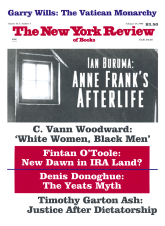In response to:
The Big Rock Candy Mountain from the December 18, 1997 issue
To the Editors:
Anyone of the slightest aesthetic sensibility has to agree with Martin Filler’s criticism of the new Getty Museum and of the self-serving publications from the Committee of Trustees and from the architect. The late Mr. Getty was indeed of the view that a camel was a horse designed by a committee. He called his corporate committeemen “my flying cowboys,” and as a lonely and wise entrepreneur he distanced himself geographically as far as possible from them by going to live in Europe for over half his adult life, including the last twenty-six years before his death. There his architectural preferences were shown as he acquired the sixteenth-century Sutton Place, near London, also an Odeschalchi villa outside Rome, and, as absentee owner of a property at Malibu, he chose another Roman villa as the model for the first museum. It is quite extraordinary therefore to see the the alacrity with which the Getty trustees have departed from the donor’s known taste. It is true that they found themselves with an “unexpected” increase in the endowment when they joined the executors in selling the founder’s company! It is also true that many European countries restrict the export of works of art. But why did they not let the art live where Getty himself had lived? Create a Getty Museum in England and another in Italy. They could then have bought every great work of art which had come up for sale in those two art-rich countries, and, from time to time, sent these separate collections for temporary exhibitions in America. No export licenses would have been required. It was what Getty’s friend, Thyssen, did, and it is similar to what the Guggenheim is doing today. The late J. Paul Getty was a Jamesian American with a great love for Europe and for European art. The terms establishing the foundation obliged the trustees to name this building after the founder. He might have been happier if they had not done so.
Claus von Bülow
London, England
To the Editors:
In his review of the new Getty Center, Martin Filler writes rather disparagingly that the Los Angeles County Museum of Art has “a negligible permanent collection of paintings” [NYR, December 18, 1997]. It is not so. Mr. Filler may consider negligible major works by Giovani di Paolo, Rosso Fiorentino, Guido Reni, Rembrandt, Frans Hals, Cézanne and Gauguin, or closer to Mr. Filler’s own interests, Matisse, Picasso, Tanguy, or Motherwell. It is however unfair not to recognize that the Los Angeles County Museum has been for the last twenty years a major presence in the field of Old Master paintings, and that through the continuing support of the Ahmanson Foundation it remains one of the few American museums steadily building a great collection of European paintings. I encourage readers of Mr. Filler’s article to correct his misperception by visiting the Los Angeles County Museum of Art on their next visit to California.
J. Patrice Marandel
Curator
Department of European Painting and Sculpture
The Los Angeles County Museum of Art
Los Angeles, California
Martin Filler replies:
I fully concur with Dr. Marandel that people ought to visit the Los Angeles County Museum of Art, where they will find some superb examples of Indian and Southeast Asian sculpture, widely regarded to be among the institution’s finest holdings. However, I know of no art historian who would maintain that the museum’s Old Master paintings, apart from a few exceptional examples, are anywhere as important in toto as those owned locally by the J. Paul Getty Museum or the Norton Simon Museum, to say nothing of much finer pictures in the public galleries of several much smaller American cities. Despite the admirable generosity of such civic-minded Los Angeles County Museum donors as the Ahmanson family and Anna Bing Arnold, it remains that its picture collection simply is not commensurate with the size and wealth of America’s second city. And for the record, my own interests are not closer to the art of the twentieth century. To paraphrase W.C. Fields, I’d rather be in Berlin, whose Gemäldegalerie collection of Old Masters, I feel safe in saying, puts all the aforementioned museums into the shade.
This Issue
February 19, 1998



